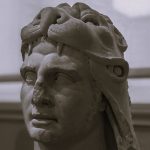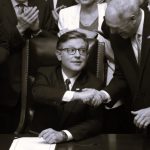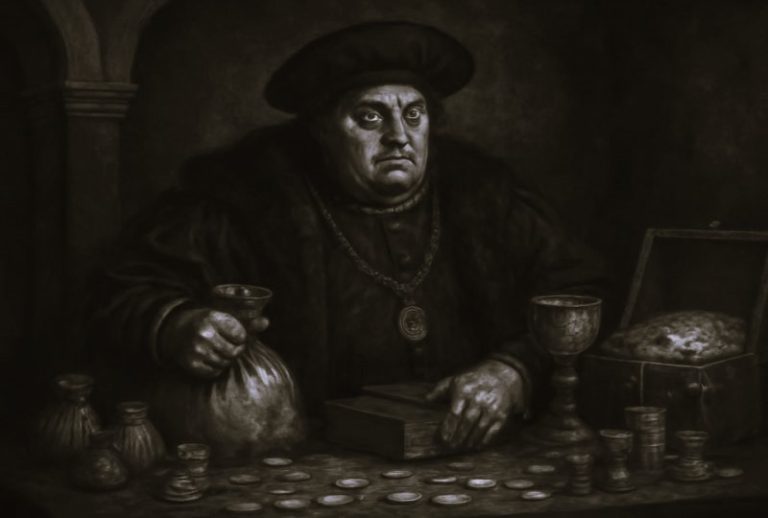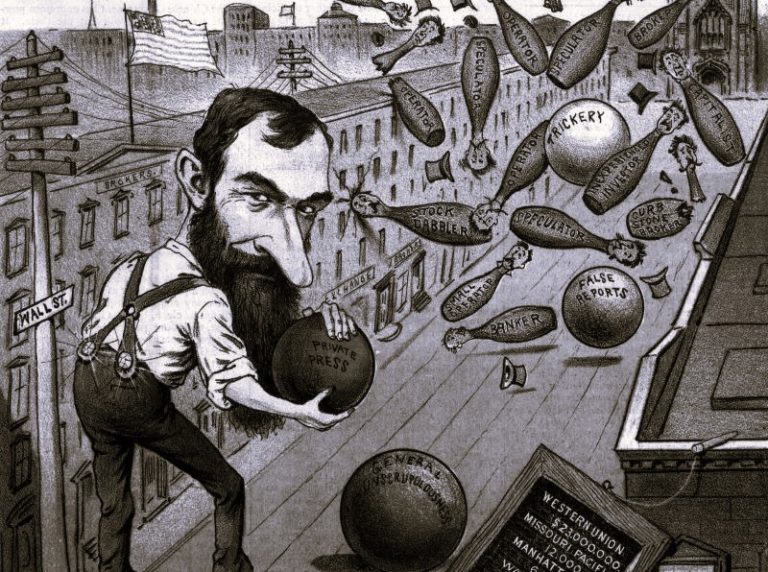


By Dr. Karlos K. Hill
Associate Professor of History
Chair, Clara Luper Department of African and African-American Studies
University of Oklahoma
This article, Photographing the Tulsa Massacre of 1921, was originally published in The Public Domain Review under a Creative Commons Attribution-ShareAlike 3.0. If you wish to reuse it please see: https://publicdomainreview.org/legal/
The Catalyst
During the early twentieth century, the Greenwood District of Tulsa, Oklahoma, was known as the “Negro Wall Street of America” because of its prosperous Black business community. In 1921, Greenwood was home to nearly eleven thousand Black people — one-tenth of Tulsa’s overall population — and spanned a thirty-five-block area. The district boasted close to two hundred businesses, including thirty-one restaurants, more than two dozen grocery stores, five hotels, four drugstores, and two theaters. There were a dozen churches, as well as two schools, two hospitals, two newspapers, and a public library.1

Most of the businesses and residential properties were owned by Black Tulsans.2 The Black professional class comprised not only clergy and teachers but also three lawyers, including the pioneering Buck Colbert Franklin; fifteen doctors, one of whom was a nationally acclaimed surgeon, Dr. A. C. Jackson; and enterprising businessmen such as Greenwood’s founder, O. W. Gurley.3 Remarkably, the neighborhood’s affluence occurred at a time when most Black southerners lived in rural areas and toiled as sharecroppers on white-owned plantations. For all these reasons, the Greenwood District was not just a wealthy Black community in the age of segregation; it was, and remains, a potent symbol of Black excellence. The eruption of white mob violence in downtown Tulsa on May 31, 1921, interrupted Greenwood’s historic ascendancy.

What has come to be known as the 1921 Tulsa Race Massacre was instigated by speculation that nineteen-year-old Dick Rowland, who was Black, had attacked Sarah Page, a seventeen-year-old white elevator operator. While it is unclear precisely what occurred during the brief interaction between the two in an elevator in Tulsa’s downtown business district on May 30, we know that Page screamed and Rowland fled the elevator in a panic. There is no record of what Page told bystanders or the police who interviewed her following the incident, but police authorities were left with the impression that Rowland had attacked her.4
The following afternoon, on May 31, the Tulsa Tribune published an incendiary article, “Nab Negro for Attacking Girl in an Elevator”, which asserted that Rowland had indeed assaulted Page.5 As was common for the era, the Tribune insinuated that he had attempted to rape her.6 Word began to spread about the alleged attack, and by evening a large number of whites had begun to gather in front of the Tulsa County Courthouse, where Rowland was being held in the county jail. It quickly became clear that some among the crowd intended to lynch him.7
Fearing that the lynching of Dick Rowland was imminent, a small, armed contingent of Black men, some of whom had served in World War I, came to the courthouse around 9:00 p.m. to offer the authorities their assistance. They left upon being promised that no harm would come to Rowland, but their brief presence further enraged the growing white mob. By 9:30 there were almost two thousand angry whites milling around outside the courthouse, many with guns, and the county sheriff was preparing his deputies to make a stand should the building be attacked. When a second, larger group of Black men arrived in hopes of helping to protect Rowland, they were again told that their services were not needed. This time, however, a white bystander, perhaps angered by the sight of Black men carrying weapons, attempted to take the gun of a Black veteran who was walking away with the rest of the group. As the men struggled, one of their guns went off. In the chaos of the moment, armed whites began shooting indiscriminately at the retreating Black men, some of whom shot back. In that first quick interchange of gunfire, twenty people were killed or wounded. The Black men hastily left the scene, but they were followed by armed whites, who engaged them in further gunfire on Fourth Street and then on Cincinnati Avenue, resulting in additional casualties. That initial pursuit ended when what was left of the group of Black men made it across the tracks of the Saint Louis–San Francisco Railway (popularly known as the Frisco Railroad), the demarcation line between white Tulsa and Black Tulsa.

Believing that the armed Blacks had instigated the firefight, Tulsa authorities joined forces with the enraged white civilians who had been at the courthouse, and together they set out to put down the “negro uprising”.8 Tulsa police haphazardly appointed between 250 and 500 white men (and even white youth) as “special deputies”, granting them the authority to arrest as well as shoot and kill Black people whom they viewed as in rebellion against white Tulsans.9 According to one eyewitness and participant in the massacre, the deputized whites were specifically told to “get a gun and get a nigger”.10
When a group of Black men gathered north of the Frisco tracks, forming a defensive wall to prevent the swelling white mob from crossing en masse into Black Tulsa, they were violently confronted around midnight by the Tulsa police, the local unit of the Oklahoma National Guard, and the hastily assembled contingent of armed “deputies”.11 Whites who had already made it into the Black community were now shooting randomly through windows and setting homes and businesses on fire. In at least a few cases, Blacks were deliberately murdered, including an elderly couple who were gunned down inside their home. The most destructive and perhaps deadliest race massacre in American history had begun, and it would continue unabated for approximately twelve hours. By noon on June 1, by one contemporaneous estimate, as many as three hundred people had been killed, and Greenwood’s business district, as well as more than one thousand Black residences, lay in ashes.12

The vast majority of contemporaneous press coverage, official reports, and subsequent histories refer to the events of May 31 and June 1, 1921, as the “Tulsa Race Riot”. To be sure, since the middle of the nineteenth century, “race riot” has been the generic term used to describe outbreaks of violence between different racial or ethnic groups.13 In the past five years, however, there has been a growing consensus within the news media and the general public around “race massacre” as the more appropriate descriptor, which is part of a larger effort to tell the story of what occurred from the vantage point of the Black victims and survivors.14 The Tulsa Race Massacre Centennial Commission (2015–present), headed by Oklahoma state senator Kevin Matthews, is to be applauded for its leadership in initiating the conversation about how the events can be most accurately framed.15 I believe the shift in terminology from “race riot” to “race massacre” is a necessary and timely corrective.
First and foremost, the word “massacre” better captures what actually occurred. Had the Black community been able to keep the white invaders from entering the Greenwood District, or had the violence subsided that same night, the term “riot” might be more apt. The following morning, however, white civilians and authorities banded together to launch a systematic assault on Black people and property, and that coordinated incursion places the subsequent events squarely in the realm of a massacre.
According to testimony from both Black and white eyewitnesses, by daybreak on June 1, several thousand armed whites had amassed in various locations along the southern border of the Greenwood District.16 At approximately 5:00 a.m., a whistle or siren was sounded as a signal for the invasion to begin. As the white mob stormed into Greenwood, a machine gun that had been set up atop a grain elevator sprayed bullets into Black homes, businesses, and churches along Greenwood Avenue. Airplanes flew overhead, from which whites reportedly fired pistols and shotguns (and even dropped rudimentary explosives) down at Blacks fleeing the violence.17

Once in Greenwood, the invading whites, civilians as well as authorities, reportedly shot and killed any Black person who was found to be armed or who did not immediately surrender, including some who were simply attempting to flee from the violence.18 Faced with this overwhelming show of force, Black Tulsans reluctantly emerged from their homes, surrendered whatever weapons they possessed, and were taken into custody.

They were transported to temporary detention centers — at Convention Hall until it was full, and then to McNulty Park and the fairgrounds — where they were held until they were able to get a white person to vouch for them. There is no evidence that any of the whites involved in the mob violence were detained by authorities, let alone arrested.
Violence and Legacy
Some buildings in Greenwood had already been set ablaze during the nighttime fighting, but whites now systematically looted homes, churches, and businesses and then set them on fire.19 After some twelve hours of continuous mob violence, almost every significant structure within the thirty-five-block area had been burned to the ground or severely damaged. The invasion of the Greenwood District, in other words, was a far cry from a “race riot” or merely an outbreak of violence between two different racial or ethnic groups: it was an intentional military-style assault on a civilian community.
The financial losses were staggering, totaling approximately $2 million ($26 million in today’s dollars) of Black wealth.20 White-owned stores that had been looted by whites seeking guns and ammunition during the massacre later received restitution, but even though insurance companies and the city of Tulsa initially promised to recompense Black business owners and Black residents who had lost everything, they never made good on such reparations.21 Furthermore, Tulsa-area banks and lending institutions refused to provide loans to Black businesses and homeowners seeking to rebuild.22
In retrospect, the actions of the white mob and local authorities can only be interpreted as a concerted attempt to expel Tulsa’s Black community, as had happened elsewhere in the region.23 Seemingly underlining this point, a photo of Greenwood engulfed in heavy smoke is captioned “Runing [sic] the Negro out of Tulsa”.

Despite the best efforts of the white mob and the city’s leaders, Black Tulsans rebuilt the Greenwood District brick by brick. By 1942, according to attorney and historian Hannibal Johnson, the district had reached its zenith, with more than 242 Black-owned and Black-operated businesses.24 In the final analysis, an important legacy of the Tulsa Race Massacre has proven to be the grit and resilience of the Black survivors.
Photographing a Massacre

Not only is the 1921 Tulsa Race Massacre the most destructive episode of anti-Black violence in American history, but it is likely one of the most photographed episodes as well. In conducting the research for The 1921 Tulsa Race Massacre: A Photographic History, I reviewed more than five hundred photos of the massacre.25 To my knowledge, similar outbreaks of anti-Black violence in Chicago (1919), Elaine, Arkansas (1919), and Rosewood, Florida (1923), did not produce an equivalent number of photos. Not only does the large cache of extant photographs afford us an opportunity to understand the depth and ferocity of anti-Black violence during the post-World War I era, but the images also provide an unvarnished glimpse into the psychological underpinnings of white supremacist violence, revealing the documentary choices that white participants made as the massacre unfolded. Moreover, the sheer number of these photos is illustrative of how photographing brutal acts of anti-Black violence had become an important social ritual in early-twentieth-century America. Because so many photos of the race massacre are still available to us today, we are compelled, even obliged, to engage with them. In reckoning with this pictorial legacy, there are some questions we must ask ourselves: Why do so many photos exist? Who took them? What do they tell us about the events they depict? In addressing these questions with sensitivity and empathy, I hope that I can use the photos to shed greater light on aspects of the race massacre that might be faint or imperceptible in other documentary sources.

An extensive race massacre photo archive exists because so many white participants desired to visually represent and share with other whites their role in the violent destruction of the Greenwood District. Of the more than five hundred photographs I reviewed, only the half-dozen images by photographer Reverend Jacob H. Hooker, himself a survivor of the massacre, are attributed to a Black person (unfortunately, his photography studio, located at 22 North Elgin Avenue, was burned down during the massacre and was never rebuilt).White Tulsans’ eagerness to photograph the community’s devastation was reflective of turn-of-the century lynching culture, in which photography was central. By and large, lynching culture revolved around white mobs torturing and summarily killing Black people in public. White-on-Black lynching often became a public spectacle, with as many as several thousand people in attendance. White mobs sought to portray the white community as undifferentiated and united in enacting white supremacy through terroristic violence enacted upon Black bodies. For example, photo postcards of lynchings often pictured a crowd of gleeful whites posing near a lynched Black body.26 According to historian Amy Wood, there was an appetite among white Americans for witnessing a lynching because it gave them social authority in telling the story as well as the ability to frame themselves as protectors of the community.27
The white Tulsans who invaded Greenwood similarly portrayed themselves as protectors, defending their community against an armed “negro uprising”. Through taking or sharing photos of destroyed Greenwood buildings and, especially, of armed whites escorting Black men with their hands raised in surrender, white participants and onlookers sought to demonstrate that white Tulsans had succeeded in thwarting Black violence. Captions such as “Running the Negro out of Tulsa”, “Little Africa on Fire”, and “Herding Them in the Convention Hall” are indicative of this cultural ethos.28 Race massacre photos were valued as souvenirs that enabled their authors to credibly inscribe themselves into a triumphalist narrative.29 This is particularly true of those later sold as photo postcards, which also allowed those who purchased and sent them, as well as the recipients who then viewed them, to vicariously share in that triumph.

Although white mob participants enthusiastically took pictures of Greenwood’s destruction, most did not leave a documentary record that would later allow their photos to be traced back to them. This was not an uncommon dynamic. As with lynching photography, rarely did white photographers or whites pictured in race massacre photos identify themselves. The bulk of the images for which a specific creator can be identified were taken by amateur white male photographers. For example, Francis Albert Schmidt, who was the University of Tulsa’s football coach at the time, and University of Tulsa alumnus Joseph McMinn Hause are known to have taken some of the photos that document the detention of Black Tulsans at Convention Hall and McNulty Park.30 In contrast to others’ wide-angle images, Schmidt’s and Hause’s photos provide close-up views of Black families being searched by deputized whites and then loaded onto waiting trucks. In addition, there are approximately a half-dozen extant photos by Schmidt of the corpses of Black massacre victims. Like his detention images, these photos were taken at close range, revealing victims’ facial expressions, wounds, and personal effects. As many as three hundred people are estimated to have died as a result of the massacre, and yet it is rare to find photos that provide visual evidence of the fatalities.

It is unlikely that Schmidt’s and Hause’s photos were intended to document the Black experience of the race massacre; nevertheless, they bring into stark focus the horrific violence suffered by Tulsa’s Black community. At the time, only the state’s Black newspapers (particularly Oklahoma City’s Black Dispatch) and nationally distributed Black newspapers such as the Chicago Defender carried stories on the massacre from the vantage point of Black victims and survivors, under headlines such as “Loot, Murder, Arson! Four Million Dollars Lost”, “Tulsa Aflame; 85 Dead in Riot”, and “Police Aided Tulsa Rioters”.31 Rather than send reporters and photographers to Tulsa to cover the massacre directly, the editors repurposed photos circulating in white dailies to illustrate how white mob violence coupled with the complicity of city officials led to high Black fatalities and to Greenwood’s physical destruction.

Some of the most memorable photos of the massacre were taken not by amateurs but by two of Tulsa’s established professional photographers, Clarence Jack and Alvin Krupnick. A week following the massacre, one of Krupnick’s most compelling images was published in the New York Times.32 Depicting a dejected Black female survivor sitting on the back of a truck with her few salvaged possessions, exhaustion and desperation clearly etched on her face, it evocatively captured the human tragedy of the massacre. In the days and months ahead, Krupnick would continue to photograph the Greenwood District and its Black survivors. His post-massacre photos document Greenwood’s gradual reemergence from rubble-filled ruins, to a tent city, to restored homes and businesses. Krupnick’s race massacre photography is both eloquent and historically important, but there is another point that should not be overlooked: as the owner of a commercial studio, he likely processed numerous photos for white customers who had taken part in the massacre.

It has long been rumored that Tulsa police were sent to photography studios throughout the city to confiscate any massacre photos that were being developed. While this rumor has never been either disputed or confirmed by archival research, a box containing confiscated photos allegedly surfaced at the Tulsa police station more than fifty years later, in 1972 or 1973. A sergeant purportedly showed the photos to several officers in a break room. Thirty years later, one of the officers who had seen the confiscated photos shared the story with archivist and local historian Dick Warner. He told Warner that the photos he viewed were gruesome. One he remembered showed the lifeless bodies of a Black man, a Black woman, and two children draped over a fence. In another, a Black man was being dragged behind a car. Several of the photos, he believed, showed white men digging trenches in which the bodies of Black massacre victims were being dumped. After this brief reemergence, the confiscated photos seemingly disappeared again; and despite the efforts of historians Dick Warner and Scott Ellsworth to locate them, they have not been found.33
While some undoubtedly would rather not acknowledge this episode in Oklahoma’s history, what happened in Tulsa during those two days in 1921 must never be forgotten. As the images collected here and in my book make clear, it is essential that we choose to remember the race massacre. And it is essential that we do so in ways that center the victims and survivors.
Far From Justice
I am not someone who should be shocked by these photos. Throughout my career, I have studied dozens of lynching photos that include scenes of white vigilantes torturing Black bodies. Nonetheless, when I first viewed images of the Tulsa Race Massacre, I could not look away. I felt compelled to continue looking at more and more photos, trying to come to a clearer understanding of exactly what transpired during the explosion of white mob violence that has come to define both the Greenwood District and Tulsa itself.
There is an eerie quality, even a surreality, to these photos. At first glance, they call to mind photographs of Berlin, Germany, after weeks of aerial bombardment during World War II. In many ways, I still cannot believe what the photos make clear: a residential neighborhood spanning thirty-five blocks was burned to the ground in a matter of hours. Without the photographic evidence, the claim that a community the size of the Greenwood District was reduced to rubble would seem dubious, even audacious. In this way, race massacre photos are portals to the past. They help bring into view aspects of this history that might otherwise be denied or forgotten. Despite the indisputable visual evidence, however, we can never know with certainty everything that happened during the twelve hours of violence that destroyed the Greenwood District. We can never fully know what it was like to experience the terror of witnessing loved ones being killed, family members being interned, or one’s community being destroyed.
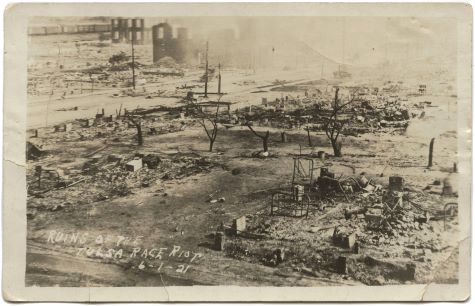
Perhaps the most chilling photos are those that show whites standing over the bodies of deceased Blacks or posing in front of building ruins. Who were the individuals pictured in these photos? Were they involved in the death and destruction, or were they mostly looters or curiosity seekers? Might white contemporaries viewing the photos today recognize the face of a friend or family member? If so, would they be willing to come forward with identifying information for those individuals? Of course, merely knowing the names of white participants and spectators would be far from justice, but it would nonetheless be significant, in that it would remove white anonymity and provide at least a measure of accountability for some whites’ role in the massacre. Unfortunately, it is doubtful that we will ever know the identities of the white civilians and civil authorities who participated in the destructive frenzy in the Greenwood District. When it comes to anti-Black violence, justice is too often permanently deferred.

And what about the unidentified Black victims depicted in these photos? Having spent countless hours studying the images, I am haunted by the thought of how afraid and alone they must have felt in their last moments, and by the pain they must have suffered. I am haunted by my inability to discern who they were in life and to know whether their surviving family members were able to provide them a proper burial and thereby gain some sense of closure. I am haunted by the idea that photographed victims were revictimized by being tossed into a mass grave. One hundred years have passed since the race massacre, and yet these questions are more imperative than ever before.

While I am saddened by the number of photos that were taken of the race massacre, I am thankful that so many of them survived, because they have made it impossible for the scope of the violence and destruction to be denied. The need to confront the white supremacy embedded in these images, as well as the histories and contemporary realities of racial segregation and anti-Black racism that gave rise to the massacre, is a lesson that I hope readers will remember. These images should challenge all those who view them to think deeply about our relationship to this history. They should force us all to think about our collective responsibility for the present-day legacies of the race massacre. Current-day residents in Greenwood often remark that they are haunted by the feeling that they are walking atop Black bodies buried in mass graves.
The recent initiative to identify mass graves will be important in bringing the community some measure of closure in regard to one of the race massacre’s most polarizing legacies. Nonetheless, our collective responsibility must also include vigorous action in regard to reparations for descendants of victims and survivors. Questions of restitution and atonement are never easy, but unless we can address them with honesty and fairness, there is little hope that authentic reconciliation can ever occur. I hope this photographic history of the race massacre will galvanize critical dialogue that can move us in the direction of justice for race massacre victims, survivors, and their descendants.
Appendix
Endnotes
- Larry O’Dell, “Riot Property Loss”, in Oklahoma Commission to Study the Tulsa Race Riot of 1921, Tulsa Race Riot: A Report (Oklahoma City, 2001), 144.
- O’Dell, 149.
- Profiles of Greenwood’s most notable residents can be found in Hannibal B. Johnson, Black Wall Street: From Riot to Renaissance in Tulsa’s Historic Greenwood District (Austin, TX: Eakin Press, 2007), chapter 1.
- Scott Ellsworth, Death in a Promised Land: The Tulsa Race Riot (Baton Rouge: Louisiana State University Press, 1992), 44-47; Randy Krehbiel, Tulsa, 1921: Reporting a Massacre (Norman: University of Oklahoma Press, 2019), 35-36.
- Krehbiel, Tulsa, 1921, 36–37.
- See Jacqueline Dowd Hall, “‘The Mind That Burns in Each Body’: Women, Rape, and Racial Violence”, Southern Exposure 12 (1984): 61–71; For three excellent treatments of lynching and the “protection of womanhood” discourse, see Hall, Revolt Against Chivalry: Jessie Daniel Ames and the Women’s Campaign Against Lynching (New York: Columbia University Press, 1993); Crystal N. Feimster, Southern Horrors: Women and the Politics of Rape and Lynching (Cambridge, MA: Harvard University Press, 2009); and Estelle B. Freedman, Redefining Rape: Sexual Violence in the Era of Suffrage and Segregation (Cambridge, MA: Harvard University Press, 2013).
- Krehbiel, Tulsa, 1921, 43.
- Krehbiel, 43–46; Scott Ellsworth, “The Tulsa Race Riot” in Oklahoma Commission, Tulsa Race Riot, 63.
- Ellsworth, 64.
- Ellsworth, 64.
- Alfred Brophy, Reconstructing the Dreamland: The Tulsa Riot of 1921; Race, Reparations, and Reconciliation (New York: Oxford University Press, 2002), 58–59.
- In his narrative report, dated December 31, 1921, Disaster Relief Director Maurice Willows asserted that estimates for the number killed ranged from fifty-five to as many as three hundred. Due to hasty burials and the lack of recordkeeping, he acknowledged that an accurate accounting of the number of people killed during the race massacre was impossible. Willows’ narrative report is reprinted in Johnson, Black Wall Street, 200–216. A scanned copy can be consulted at https://www.tulsahistory.org/wp-content/uploads/2018/11/1921-Red-Cross-Report-December-30th.pdf.
- See Bernard F. Robinson, “The Sociology of Race Riots”, Phylon 2, no. 2 (1941): 162–171; Linda K. Kerber, “Abolitionists and Amalgamators: The New York City Race Riots of 1834”, New York History 48, no. 1 (1967): 28–39; John M. Werner, Reaping the Bloody Harvest: Race Riots in the United States during the Age of Jackson, 1824–1849 (New York: Garland, 1986); Dominic J. Capeci Jr., “Foreword: American Race Rioting in Historical Perspective”, in Walter Rucker and James Nathaniel Upton, eds., Encyclopedia of American Race Riots, 2 vols. (Westport, CT: Greenwood Press, 2007), vol. 1, xix–xlii and “Introduction”, xlv–liii. See also David Grimsted, American Mobbing, 1828–1861: Toward Civil War (New York: Oxford University Press, 1998).
- Samuel Hardiman,“‘Race Riot Is a Euphemism’: Teachers Learn Why Tulsa Race Massacre Is More Accurate Term”, Tulsa World, June 12, 2018, <https://www.tulsaworld.com/news /local/education/race-riot-is-a-euphemism-teachers-learn-why-tulsa-race/article_37e95c53- 9f55-5ba8-8ffa-c5586946a420.html>; “Tulsa Race Massacre”, History.com, March 8, 2018, updated October 21, 2019, https://www.history.com/topics/roaring-twenties/tulsa-race-massacre; “Tulsa Race Massacre”, in The Encyclopedia of Oklahoma History and Culture (online), https://www.okhistory.org/publications/enc/entry.php?entry=TU013; “1921 Tulsa Race Massacre” (online exhibit), Tulsa Historical Society and Museum, https://www.tulsahistory.org/exhibit/1921-tulsa-race-massacre/.
- Randy Krehbiel, “Tulsa Race Riot Centennial Commission Announced”, Tulsa World, February 25, 2017, https://www.tulsaworld.com/news/local/government-and-politics/tulsa-race-riot-centennial-commission-announced/article_0d2b43c2-1ef4-59f3-a21ad9c0a6b90d8a.html. See also the commission’s website, https://www.tulsa2021.org.
- Brophy, Reconstructing the Dreamland, 62–63; Krehbiel, Tulsa, 1921, 71.
- For documentation and a careful analysis of the use of airplanes in the assault on Greenwood, see Richard S. Warner, “Airplanes and the Riot”, in Oklahoma Commission, Tulsa Race Riot, 103–108.
- Ellsworth, “Tulsa Race Riot”, 74–79.
- Ellsworth, “Tulsa Race Riot”, 74–79.
- O’Dell, “Riot Property Loss”, 149.
- O’Dell, 145.
- Johnson, Black Wall Street, 99.
- See Kimberly Harper, White Man’s Heaven: The Lynching and Expulsion of Blacks in the Southern Ozarks, 1894–1909 (Fayetteville: University of Arkansas Press, 2012). See also Guy Lancaster, “‘They Are Not Wanted’: The Extirpation of African Americans from Baxter County, Arkansas”, Arkansas Historical Quarterly 69, no. 1 (2010): 28–43; Lancaster, “Nightriding and Racial Cleansing in the Arkansas River Valley”, Arkansas Historical Quarterly 72, no. 3 (2013): 242–264; and Lancaster, “‘There Are Not Many Colored People Here:’ African Americans in Polk County, Arkansas, 1896–1937”, 70, no. 4 (2011): 429–449.
- Johnson, Black Wall Street, 116.
- The most significant collections of photos were donated to the Oklahoma Historical Society, the Tulsa Historical Society, the University of Tulsa, the Library of Congress, the University of Oklahoma, and Northeastern Oklahoma State University.
- For a photographic example of a spectacle lynching along with an extended discussion of lynching culture, see Karlos K. Hill, Beyond the Rope: The Impact of Lynching on Black Culture and Memory (New York: Cambridge University Press, 2016), chaps. 2–3.
- For a more detailed discussion of spectacle lynchings as representative of white supremacy, see Amy L. Wood, Lynching and Spectacle: Witnessing Racial Violence in America, 1890–1940 (Chapel Hill: University of North Carolina Press, 2009), 87–92.
- For “Herding Them in the Convention Hall”, see Tulsa Race Massacre Collection, Tulsa Historical Society and Museum, catalog number 2018.118.009.
- Of the five hundred race massacre photos I analyzed, approximately two dozen had been transformed into photo postcards and subsequently sold commercially.
- For biographical information on known race massacre photographers, see I. Marc Carlson,
- For examples of Black newspaper coverage of the race massacre, see Black Dispatch, June 11, October 22, and December 8, 1921; and Chicago Defender, June 4, June 11, and June 18, 1921.
- See New York Times, June 8, 1921, 1, col. 1. For information regarding the city of Tulsa’s investigation into mass graves, see Mihir Zaveri, “Nearly 100 Years after Tulsa Massacre, City Plans to Search Cemetery for Victims”, New York Times, February 5, 2020, <https:// www.nytimes.com/2020/02/05/us/tulsa-race-massacre-mass-grave.html>; Kurtis Lee,“Tulsa Finally Decides to Address 1921 Race Massacre with Search for Mass Grave”, Los Angeles Times, February 4, 2020, https://www.latimes.com/world-nation/story/2020-02-04/tulsa-set-to-excavate-bodies-from; and Nehemiah D. Frank, “Researchers Have Found Evidence of Mass Graves from the 1921 Tulsa Race Massacre. Here’s Why That News Is Bittersweet for My Community”, Time, December 18, 2019, https://time.com/5752347/tulsa-mass-graves-race-massacre/.
- Information regarding the rumored Tulsa police confiscation of race massacre photos and he subsequent cover-up is outlined in a memo from Dick Warner to Scott Ellsworth dated June 12, 2002. The memo is in this author’s possession.
Public Domain Works
- NAACP Photographs of Race Riots in Tennessee, California, and Oklahoma (Library of Congress, 1921-1946)
- Oklahoma State University Tulsa Race Massacre of 1921 Archive (Oklahoma State University Library, 1921)
- Images of the Race Massacre at University of Tulsa (McFarlin Library Special Collections Gallery, 1921)
- Southern Methodist University Tulsa Race Riot Postcards (SMU Libraries Digital Collections, 1921)
- Smithsonian Collection of Tulsa Race Massacre Images (Smithsonian, 1921-2005)
- “A Descriptive Poem of the Tulsa Riot and Massacre” (A.J. Smitherman ca. 1921)
